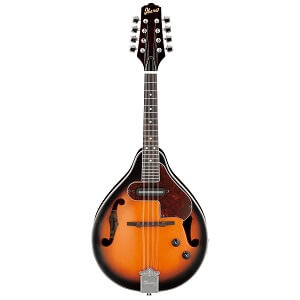Mandolin
 The mandolin can be described as a small, short-necked lute with eight strings. A lute is a chordophone, an instrument which makes sound by the vibration of strings. As a descendent of the lute, the mandolin reaches back to some of the earliest musical instruments.
The mandolin can be described as a small, short-necked lute with eight strings. A lute is a chordophone, an instrument which makes sound by the vibration of strings. As a descendent of the lute, the mandolin reaches back to some of the earliest musical instruments.
The strings of a mandolin are tuned to the same pitches as those of the violin (G-D-A-E), although it is distinguished by its doubled-up strings for a total of eight strings that produce a great deal of sound for such a small body. Like the guitar, the mandolin is part of the lute family and some of its early ancestors include the Arabic oud. As early lute instruments traveled across the Mediterranean and into Europe, new variations developed, such as the mandora that emerged in the sixteenth century.
Finally, in the mid-nineteenth century, the Neapolitan mandolin—more commonly known as a bowlback mandolin—developed in Italy. Mandolins became wildly popular towards the end of the nineteenth century, when mandolin orchestras (featuring mandolin, tenor mandolin, mandola, mandocello, and other members of the mandolin family) took off in popularity in communities and on entertainment circuits. European immigrants who brought mandolins with them to the Americas in the same time period likewise formed their own new mandolin orchestras. In the South, bowlback mandolins were nicknamed “taterbug” mandolins for their shape and striped resemblance to the Colorado potato beetle (Leptinotarsa decemlineata)—a common garden pest of the region.